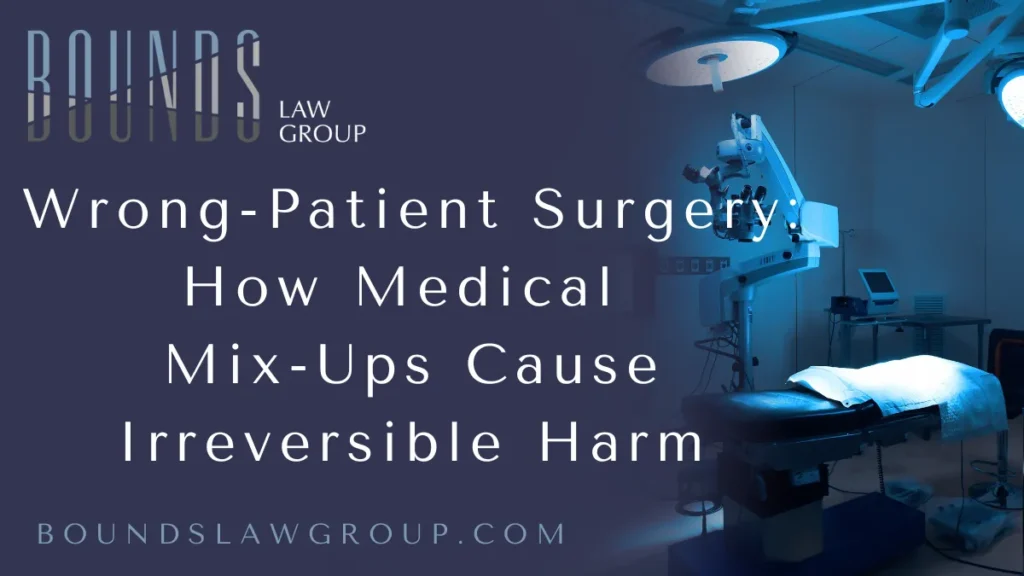
The Tragedy of Wrong Patient Surgery Malpractice | Bounds Law Group
Wrong patient surgery malpractice is one of the most devastating forms of medical negligence. This critical error occurs when a surgeon operates on the incorrect patient or performs the wrong procedure on a patient due to a mix-up in identification, scheduling, or documentation. Such incidents are not only horrifying but can lead to permanent injury, emotional trauma, and wrongful death. At Bounds Law Group, we hold negligent medical providers accountable for these inexcusable errors.
Call us now at 877-644-5122 or complete the free case evaluation form to begin the process before it’s too late.
The Human Cost of Medical Identity Errors
When a surgeon conducts a procedure meant for another patient, the consequences are dire. The patient may endure unnecessary surgical wounds, organ damage, post-operative complications, and emotional distress. Meanwhile, the intended patient continues without critical care, possibly leading to deterioration or death. The ripple effects reach families, caretakers, and entire healthcare systems.
A single wrong patient surgery malpractice incident disrupts lives forever. From spinal operations on the wrong individual to amputations performed without need, these errors highlight systemic failures in hospitals. Medical professionals are trained to follow strict protocols, including the “universal protocol” by The Joint Commission, which mandates time-outs, proper patient identification, and informed consent. Yet, when staff cut corners or communication breaks down, catastrophic mistakes happen.

Why Wrong Patient Surgeries Still Happen
Despite modern advancements in medical recordkeeping and digital scheduling, wrong patient surgery malpractice continues to occur due to several preventable causes:
- Failure to verify patient identity using multiple identifiers
- Mislabeled charts or imaging studies
- Lack of pre-surgical communication among teams
- Overworked staff leading to fatigue and inattention
- Rushed surgical schedules without adequate safety checks
In some hospitals, systemic pressure to maximize throughput leads to shortcuts in safety protocols. Unfortunately, patients pay the price for these administrative failures.
Types of Wrong Patient Surgery Malpractice Cases
At Bounds Law Group, we have handled various wrong patient surgery malpractice cases, including:
- Surgery performed on the wrong patient entirely, such as a gallbladder removal meant for someone else
- Wrong site surgery, where the operation is conducted on the incorrect part of the body
- Unnecessary procedures, such as organ removal or joint replacement not indicated for the patient
- Wrong gender surgeries, such as prostate removal in female patients due to chart errors
These are not rare, isolated events. According to research published in medical safety journals, these “never events” still occur hundreds of times annually in the United States alone.
What Victims Should Do After a Surgical Mix-Up
Victims of wrong patient surgery malpractice often feel powerless. They trusted a medical institution, only to suffer due to reckless or negligent behavior. Here’s what victims should do immediately:
- Seek medical attention to address the harm caused by the incorrect surgery.
- Obtain all medical records to begin building a case.
- Document symptoms, pain, and limitations following the surgery.
- Contact a qualified medical malpractice attorney immediately.
At Bounds Law Group, we provide aggressive legal representation for patients who have suffered from medical identity mix-ups. Our team investigates the chain of custody for medical records, surgical team notes, and all communication prior to the operation. We work with medical experts to prove negligence, causation, and damages — the key components of any medical malpractice claim.
How Bounds Law Group Holds Negligent Hospitals Accountable
When you work with Bounds Law Group, you’re choosing a firm that understands the depth of harm caused by wrong patient surgery malpractice. Our experienced attorneys take decisive legal action to:
- Investigate the root cause of the surgical error
- Obtain testimony from expert medical witnesses
- Secure full compensation for medical costs, future treatment, lost income, and emotional suffering
- Demand changes in hospital protocol to prevent future errors
Victims may be entitled to compensation for:
- Current and future medical expenses
- Rehabilitative therapy
- Lost wages and future earning capacity
- Pain and suffering
- Loss of enjoyment of life
- Punitive damages in cases of extreme negligence
Legal Time Limits: Don’t Wait to File Your Claim
Every state has a statute of limitations for filing a medical malpractice lawsuit. In many cases, the time limit begins from the date of injury or from when the injury was discovered. Waiting too long can permanently bar you from receiving the justice you deserve. Contacting an experienced attorney quickly ensures your rights are protected.
We offer a free case evaluation form to review your claim. Our dedicated team will assess your case, gather supporting evidence, and guide you through the legal process with clarity and compassion.
Your Recovery Starts with a Free Legal Review
Medical errors involving the wrong patient are entirely preventable. If a hospital or surgeon failed to verify identity or follow proper protocols, they must be held accountable. Start your journey to justice with a free case evaluation form or speak with one of our expert attorneys by calling 877-644-5122 today.
Preventive Measures: How Hospitals Can Avoid Wrong Patient Surgery Malpractice
While the occurrence of wrong patient surgery malpractice is undeniably alarming, it is important to highlight that preventive measures can drastically reduce the chances of these catastrophic errors. Hospitals and healthcare institutions have the responsibility to implement strict protocols and consistently enforce them to ensure patient safety and the correct execution of surgical procedures.
Adopting Standardized Identification Protocols
One of the most effective ways to prevent wrong patient surgery malpractice is by employing comprehensive and standardized identification protocols. Hospitals must adopt a two- or three-step verification process to confirm the patient's identity before any surgical procedure. This can include:
- Patient wristbands that display key identifying information, such as full name, date of birth, and medical record number.
- Photo identification to visually confirm that the correct patient is present.
- Barcode scanning of patient records and surgical consent forms to cross-check and verify details.
These methods significantly minimize the chances of misidentification. Hospitals should ensure that all personnel, from administrative staff to surgeons, are trained to follow these protocols rigorously. Failure to do so can lead to serious consequences for the patients and the medical team involved.
Surgical "Time-Outs" to Ensure Accurate Procedures
A crucial step in preventing surgical errors is the implementation of a time-out before any surgical procedure begins. The time-out is a mandatory pause during which the surgical team must confirm the patient’s identity, the correct surgical site, and the planned procedure. This practice, which is a requirement in many healthcare systems, allows the team to double-check critical details and ensure everything is in order before making any incisions.
During the time-out, the following checks should be performed:
- Verification of the patient's identity using at least two unique identifiers.
- Confirmation of the surgical site and procedure to ensure that the correct operation is being performed on the correct patient.
- Review of medical records and imaging to confirm the diagnosis and treatment plan.
This final step ensures that the surgical team is fully aligned before the procedure begins, drastically reducing the chance of an error.

Creating a Culture of Accountability and Reporting
In many cases, wrong patient surgery malpractice is a result of communication failures and lack of accountability. To address this, hospitals must foster a culture where safety is prioritized, and errors are openly reported and corrected without fear of retribution. Healthcare professionals should be encouraged to speak up if they notice discrepancies, and there should be clear channels for reporting any safety concerns.
Establishing a non-punitive reporting system helps in identifying weak points in the system and implementing corrective measures to prevent future incidents. Hospitals that prioritize transparency and encourage team members to report potential issues are far less likely to experience preventable errors.
Investing in Technology to Enhance Accuracy
With the advent of advanced medical technologies, hospitals now have the ability to utilize digital tools that assist in identifying patients and procedures accurately. From barcoding systems that link patients to their records and images to AI-driven verification platforms, hospitals can leverage these technologies to reduce human error.
For instance, electronic health records (EHR) integrated with surgical scheduling systems can provide real-time updates and ensure that all team members are working with the most accurate and up-to-date information. Using such technology minimizes the risk of paperwork or digital file mix-ups that could lead to wrong patient surgeries.
By committing to a combination of robust protocols, technology, and a culture of accountability, hospitals and medical institutions can significantly reduce the occurrence of wrong patient surgery malpractice. It is critical that the healthcare industry as a whole adopts these preventive measures to safeguard patient safety and prevent the irreversible harm caused by these errors.
Why Trust Bounds Law Group?
Our firm is built on a commitment to client advocacy, medical knowledge, and relentless pursuit of justice. At Bounds Law Group, we do not tolerate excuses from negligent healthcare providers. We pursue maximum compensation for our clients and fight to improve medical safety across the board.
- Over 20 years of malpractice litigation experience
- Proven record of high-value settlements and verdicts
- Compassionate attorneys who put your recovery first
- No fees unless we win your case
If you or a loved one were harmed by wrong patient surgery malpractice, do not suffer in silence. Call us now at 877-644-5122 for immediate legal help.
Sources
- The Joint Commission – Sentinel Event Alert on Wrong-Site Surgery
Details root causes of wrong patient and wrong site surgeries and offers safety protocol guidance.
https://www.jointcommission.org/resources/patient-safety-topics/sentinel-event/ - National Institutes of Health – Wrong Site Surgery Study
Provides in-depth analysis and statistics on the frequency and causes of surgical errors in U.S. hospitals.
https://www.ncbi.nlm.nih.gov/pmc/articles/PMC2567506/ - Agency for Healthcare Research and Quality (AHRQ) – Patient Safety Primer
Offers comprehensive explanations of wrong-patient events and best practices to avoid them.
https://psnet.ahrq.gov/primer/wrong-patient-errors

